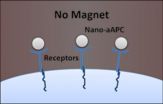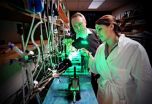(Press-News.org) Researchers from Case Western Reserve University have discovered how byproducts in the form of small fatty acids from two bacteria prevalent in gum disease incite the growth of deadly Kaposi's sarcoma-related (KS) lesions and tumors in the mouth.
The discovery could lead to early saliva testing for the bacteria, which, if found, could be treated and monitored for signs of cancer and before it develops into a malignancy, researchers say.
"These new findings provide one of the first looks at how the periodontal bacteria create a unique microenvironment in the oral cavity that contributes to the replication the Kaposi's sarcoma Herpesvirus (KSHV) and development of KS," said Fengchun Ye, the study's lead investigator from Case Western Reserve School of Dental Medicine's Department of Biological Sciences.
The discovery is described in The Journal of Virology article, "Short Chain Fatty Acids from Periodontal Pathogens Suppress HDACs, EZH2, and SUV39H1 to Promote Kaposi's Sarcoma-Associated Herpesvirus Replication."
The research focuses on how the bacteria, Porphyromonas gingivalis (Pg) and Fusobacterium nucleatum (Fn), which are associated with gum disease, contribute to cancer formation.
Ye said high levels of these bacteria are found in the saliva of people with periodontal disease, and at lower levels in those with good oral health—further evidence of the link between oral and overall physical health.
KS impacts a significant number of people with HIV, whose immune systems lack the ability to fight off the herpesvirus and other infections, he said.
"These individual are susceptible to the cancer," Ye said.
KS first appears as lesions on the surface of the mouth that, if not removed, can grow into malignant tumors. Survival rates are higher when detected and treated early in the lesion state than when a malignancy develops.
Also at risk are people with compromised immune systems: people on medications to suppress rejection of transplants, cancer patients on chemotherapies and the elderly population whose immune systems naturally weaken with age.
The researchers wanted to learn why most people never develop this form of cancer and what it is that protects them.
The researchers recruited 21 patients, dividing them into two groups. All participants were given standard gum-disease tests.
The first group of 11 participants had an average age of 50 and had severe chronic gum disease. The second group of 10 participants, whose average age was about 26, had healthy gums, practiced good oral health and showed no signs of bleeding or tooth loss from periodontal disease.
The researchers also studied a saliva sample from each. Part of the saliva sample was separated into its components using a spinning centrifuge. The remaining saliva was used for DNA testing to track and identify bacteria present, and at what levels.
The researchers were interested in Pg's and Fn's byproducts of lipopolysaccharide, fimbriae, proteinases and at least five different short-chain fatty acids (SCFA): butyric acid, isobutryic acid, isovaleric acid, propionic acid and acetic acid.
After initially testing the byproducts, the researchers suspected that the fatty acids were involved in replicating KSHV. The researchers cleansed the fatty acids and then introduced them to cells with quiescent KSHV virus in a petri dish for monitoring the virus' reaction.
After introducing SCFA, the virus began to replicate. But the researchers saw that, while the fatty acids allowed the virus to multiple, the process also set in motion a cascade of actions that also inhibited molecules in the body's immune system from stopping the growth of KSHV.
"The most important thing to come out of this study is that we believe periodontal disease is a risk factor for Kaposi sarcoma tumor in HIV patients," Ye said.
With that knowledge, Ye said those with HIV must be informed about the importance of good oral health and the possible consequences of overlooking that area.
INFORMATION:
The research was supported by a career development grant at Center for AIDS Research at Case Western Reserve University, and a National Institute of Dental and Craniofacial Research grant.
Contributing to the study were Case Western Reserve University researchers: Abdel-Malek Shahir and Nabil Bissada, from the Department of Periodontics; Xiaolan Yu, Jingfeng Sha, Zhimin Feng, Betty Eapen, Stanley Nithianantham, and Aaron Weinberg, from the dental school's Department of Biological Sciences; and Biswajit Das and Jonathan Karn, from the Department of Molecular Biology & Microbiology at the School of Medicine.
CWRU researchers find byproducts of bacteria-causing gum disease incite oral cancer growth
2014-02-25
ELSE PRESS RELEASES FROM THIS DATE:
Eliminating maternal mortality could extend life expectancy in reproductive ages
2014-02-25
Maternal death rates represent the single largest health discrepancy between developed and developing populations, with nearly all - over 99% -- maternal deaths worldwide occurring in developing countries and over half of them in sub-Saharan Africa countries. Eliminating maternal mortality, which is defined as the deaths related to pregnancy, would result in a gain of over a half year (0.6 years) in life expectancy worldwide, according to a new study by researchers at Johns Hopkins Bloomberg School of Public Health. The study is published February 13 in PLOS ONE.
Over ...
Magnetic medicine
2014-02-25
Using tiny particles designed to target cancer-fighting immune cells, Johns Hopkins researchers have trained the immune systems of mice to fight melanoma, a deadly skin cancer. The experiments, described on the website of ACS Nano on February 24, represent a significant step toward using nanoparticles and magnetism to treat a variety of conditions, the researchers say.
"Size was key to this experiment," says Jonathan Schneck, M.D., Ph.D., a professor of pathology, medicine and oncology at the Johns Hopkins University School of Medicine's Institute for Cell Engineering. ...
3-D printer creates transformative device for heart treatment
2014-02-25
Igor Efimov, PhD, at the School of Engineering & Applied Science at Washington University in St. Louis and an international team of biomedical engineers and materials scientists have created a 3-D elastic membrane made of a soft, flexible, silicon material that is precisely shaped to match the heart's epicardium, or the outer layer of the wall of the heart. Current technology is two-dimensional and cannot cover the full surface of the epicardium or maintain reliable contact for continual use without sutures or adhesives.
The team can then print tiny sensors onto the membrane ...
Vitamin A may help boost immune system to fight tuberculosis
2014-02-25
Tuberculosis is a major global problem, affecting 2 billion people worldwide and causing an estimated 2 million deaths annually. Western countries are once again tackling the disease, with recent outbreaks in Los Angeles and London.
The rise of drug-resistant TB, called a "ticking time bomb" by the World Health Organization, and the high cost of fighting the disease highlight the need for new approaches to treatment.
In findings published in the March 1 issue of the Journal of Immunology, UCLA researchers investigating the role of nutrients in helping the immune ...
Discovery of a 'conductor' in muscle development
2014-02-25
Montréal, February 25, 2014 – A team led by Jean-François Côté, researcher at the IRCM, identified a ''conductor'' in the development of muscle tissue. The discovery, published online yesterday by the scientific journal Proceedings of the National Academy of Sciences (PNAS), could have an important impact on the treatment of muscular diseases such as myopathies and muscular dystrophies.
"For several years, we have been studying myogenesis, a process by which muscles are formed during embryonic development," says Jean-François Côté, PhD, Director of the Cytoskeletal Organization ...
Psychological side-effects of anti-depressants worse than thought
2014-02-25
LIVERPOOL, UK – 26 February 2014: A University of Liverpool researcher has shown that thoughts of suicide, sexual difficulties and emotional numbness as a result of anti-depressants may be more widespread than previously thought.
In a survey of 1,829 people who had been prescribed anti-depressants, the researchers found large numbers of people – over half in some cases – reporting on psychological problems due to their medication, which has led to growing concerns about the scale of the problem of over-prescription of these drugs.
Psychologist and lead researcher, Professor ...
New record set for data-transfer speeds
2014-02-25
WASHINGTON, Feb. 25, 2014 – Researchers at IBM have set a new record for data transmission over a multimode optical fiber, a type of cable that is typically used to connect nearby computers within a single building or on a campus. The achievement demonstrated that the standard, existing technology for sending data over short distances should be able to meet the growing needs of servers, data centers and supercomputers through the end of this decade, the researchers said.
Sending data at a rate of 64 gigabits per second (Gb/s) over a cable 57 meters long using a type ...
NHS Scotland reduces post-code lottery for hip replacement surgery
2014-02-25
Tuesday 25 February – A reduction in the post-code lottery for hip replacement surgery has been achieved in Scotland without recourse to the private sector, according to new research published in the Journal of the Royal Society of Medicine. Using NHS Scotland data, researchers at the Centre for Primary Care and Public Health at Queen Mary University of London with colleagues from the University of Edinburgh and Lothian University Hospitals NHS Trust, show that access to hip replacement increased and geographical inequalities improved across all geographical health boards ...
Researchers generate new neurons in brains, spinal cords of living adult mammals
2014-02-25
DALLAS, Feb. 25, 2014 – UT Southwestern Medical Center researchers created new nerve cells in the brains and spinal cords of living mammals without the need for stem cell transplants to replenish lost cells.
Although the research indicates it may someday be possible to regenerate neurons from the body's own cells to repair traumatic brain injury or spinal cord damage or to treat conditions such as Alzheimer's disease, the researchers stressed that it is too soon to know whether the neurons created in these initial studies resulted in any functional improvements, a goal ...
Does solitary confinement fuel more crime?
2014-02-25
EAST LANSING, Mich. — Solitary confinement does not make supermax prison inmates more likely to re-offend once they're released, finds a study on the controversial penitentiaries led by a Michigan State University criminologist.
The study – one of the first to examine recidivism rates among supermax inmates – refute critics' claims that serving extended time in isolation leads to more crime. Super-maximum security units, known as supermax units or prisons within prisons, are designed to house problematic inmates by keeping them isolated for as long as 23 hours a day.
Jesenia ...




